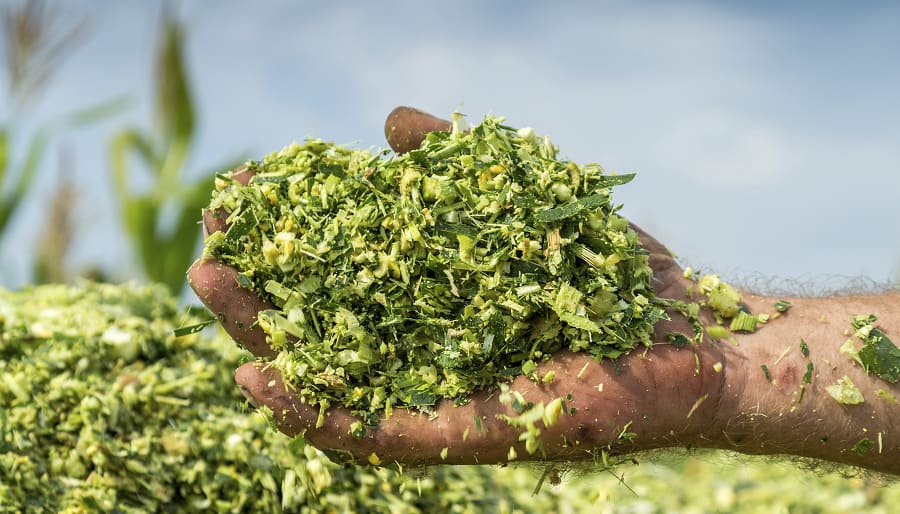
Is Silage a Complete Feed for Medium Milk-yielding Cows?
In recent months making and feeding of silage to dairy animals has picked pace of adoption which is a good sign. Silage offers several advantages: (a) the field can be harvested in a day and hence available for the next crop, (b) the crop can be harvested at an optimum age to obtain optimum DM and metabolic energy, (c) the problem of dairy-cut and carry which is labour intensive can be avoided and (d) there is ease of feeding so that farmers don’t have to spend lot of time in harvesting, chaffing and feeding. Once the silage is ready, it must go for quality analysis, otherwise, low quality silage, if not supplemented properly with other ingredients, may lead to loss in production. The foremost quality testing can be done by the farmers: (a) good quality silage when opened gives sweet vinegar-like smell (in many cases the smell could be sensed even before the silage is opened); (b) when you insert your hand in the silage, it should not be warm. Hotness to touch is indicative of contamination. Similarly, awful smell and fungus growth on the silage are indicative of contamination and such silages should be avoided.
Now we come to the question how much silage can be fed to a cow?
This depends on the dry matter requirements of the cow, which in turn depends on the productivity. Table 1 gives the DM requirements for different production levels (fat 3.5-3.8%, for higher fats the DM need to be adjusted). The challenge before the farmer is to adjust the energy, protein in the DM that can be consumed by the cow. The farmers should also remember that the DM intake in cows or buffaloes is dependent on how much NDF is present in the feed. If the feed contains more NDF, the DM intake goes down. Please refer to Table 2 to understand how the NDF affects feed intake. This question is very important in case of fresher cows (recently calved), because in these cows you need to push DM against the physiological stress of calving, changing the rumen microflora and rapidly demanding energy requirements. The cow is in the most critical stage and if proper feeding, care is not taken in that case milk production will be affected.
| Milk yields L | DM
Kg |
Protein (kg) | NDF
Kg |
Fat Kg | Energy MJ |
| 10 | 12.5 | 2.25 | 4.12 | 0.6 | 104.0 |
| 15 | 12.75 | 2.30 | 4.20 | 0.63 | 128.5 |
| 20 | 13.0 | 2.34 | 4.29 | 0.65 | 153.0 |
| 25 | 15.25 | 2.74 | 5.03 | 0.76 | 177.5 |
| 30 | 18.50 | 3.33 | 6.10 | 0.92 | 202 |
Now, let us consider various levels of silage feeding and how much energy, protein and DM it would supply. The deficit is also given, so you can think of supplementing through feed resources available to you. The intention of this article is to convey how much maize / jowar silage you can give, keeping the 33% NDF as the maximum cutoff. I am doing this exercise for a cow which is yielding 15 kg milk @3. 4% fat. In the calculations, I have considered standard maize silage having 23.5 % DM, 8.0 Protein and 10.5 energy per kg DM. First consider what is the requirements for a cow yielding 15 kg milk per day, fat 3.4%, protein 3.2%, weight 500 kg, in early lactation hence not pregnant. Good body condition score hence no allowance needed to improve BCS. The total requirements would be DM 12.5 kg, Protein 0.5 kg (@18%, NDF 4.2 kg and M.E. 128.5 MJ per day.
| Table 2: Nutrient Requirements Met with Different Levels of Silage Feeding | ||||||||
|
Silage Kg per day |
Supply | Deficient | ||||||
| DM
Kg |
Protein
Kg |
NDF
Kg |
Energy
MJ |
DM
Kg |
Protein
Kg |
NDF
Kg |
Energy
MJ |
|
| 10 | 2.35 | 0.188 | 0.26 | 24.67 | 9.65 | 2.11 | 3.74 | 103.74 |
| 20 | 4.70 | 0.376 | 0.54 | 49.35 | 7.30 | 1.92 | 3.66 | 79.15 |
| 25 | 5.75 | 0.46 | 0.66 | 60.37 | 6.25 | 1.84 | 3.54 | 68.13 |
| 30 | 7.05 | 0.57 | 0.81 | 74.00 | 4.95 | 1.73 | 3.39 | 54.5 |
Table 2 gives details of the different silage (of the above-mentioned quality) feeding levels, 10 kg, 20kg, 25 kg and 30 kg per day. The Table gives an approximate idea of how much nutrients the cow will receive from silage and the deficit to be met from other feed ingredient sources.
Such data can be generated for different production levels of cows. Through this blog the message to be conveyed is that silage although a good feed source is not complete in itself but should be combined with other ingredients. In case you are cultivating ad making your own silage, it is economically wise to adjust maximum energy and NDF requirements from silage, but for meeting the DM requirements addition of dry straw/hay and high energy density ingredients would be necessary.
(The blog is meant to simplify the understanding of feeding complexities for farmers and not an expert commentary on feed formulation).
